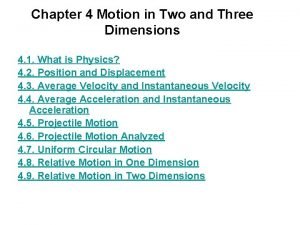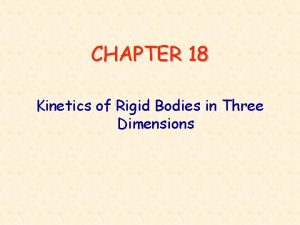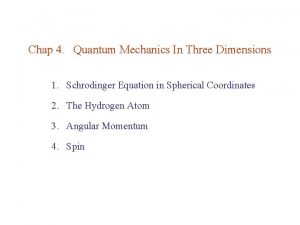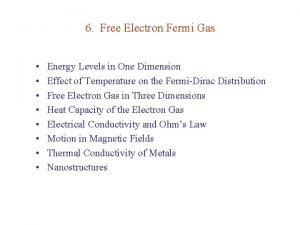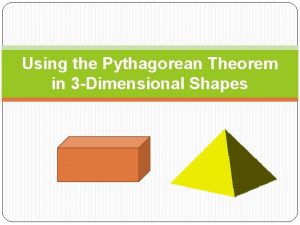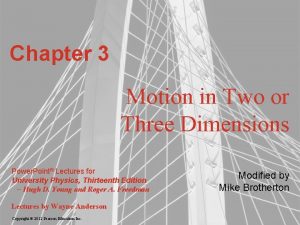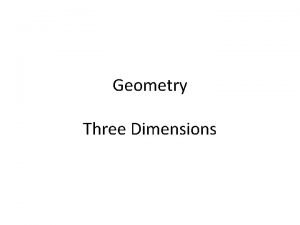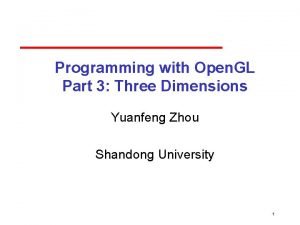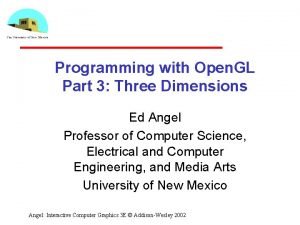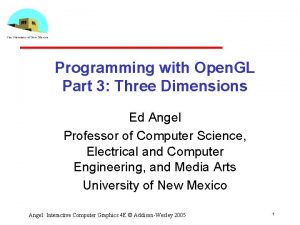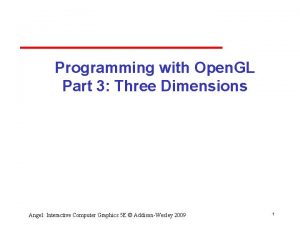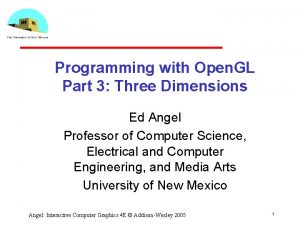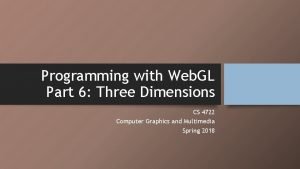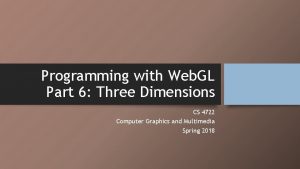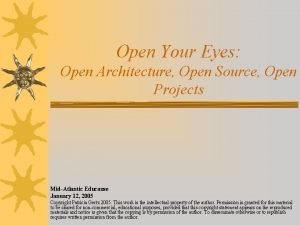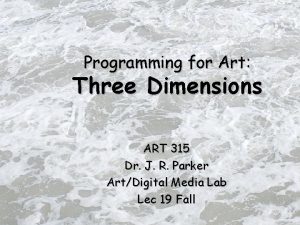Programming with Open GL Part 3 Three Dimensions






![Gasket Program #include <GL/glut. h> /* initial triangle */ GLfloat v[3][2]={{-1. 0, -0. 58}, Gasket Program #include <GL/glut. h> /* initial triangle */ GLfloat v[3][2]={{-1. 0, -0. 58},](https://slidetodoc.com/presentation_image_h/00c246927bbe5a770f5a422825d8dfb6/image-7.jpg)


![display and init Functions void display() { gl. Clear(GL_COLOR_BUFFER_BIT); gl. Begin(GL_TRIANGLES); divide_triangle(v[0], v[1], v[2], display and init Functions void display() { gl. Clear(GL_COLOR_BUFFER_BIT); gl. Begin(GL_TRIANGLES); divide_triangle(v[0], v[1], v[2],](https://slidetodoc.com/presentation_image_h/00c246927bbe5a770f5a422825d8dfb6/image-10.jpg)













- Slides: 23

Programming with Open. GL Part 3: Three Dimensions Ed Angel Professor of Computer Science, Electrical and Computer Engineering, and Media Arts University of New Mexico Angel: Interactive Computer Graphics 5 E © Addison-Wesley 2009 1

Objectives • Develop a more sophisticated three dimensional example Sierpinski gasket: a fractal • Introduce hidden surface removal Angel: Interactive Computer Graphics 5 E © Addison-Wesley 2009 2

Three-dimensional Applications • In Open. GL, two dimensional applications are a special case of three dimensional graphics • Going to 3 D Not much changes Use gl. Vertex 3*( ) Have to worry about the order in which polygons are drawn or use hidden surface removal Polygons should be simple, convex, flat Angel: Interactive Computer Graphics 5 E © Addison-Wesley 2009 3

Sierpinski Gasket (2 D) • Start with a triangle • Connect bisectors of sides and remove central triangle • Repeat Angel: Interactive Computer Graphics 5 E © Addison-Wesley 2009 4

Example • Five subdivisions Angel: Interactive Computer Graphics 5 E © Addison-Wesley 2009 5

The gasket as a fractal • Consider the filled area (black) and the perimeter (the length of all the lines around the filled triangles) • As we continue subdividing the area goes to zero but the perimeter goes to infinity • This is not an ordinary geometric object It is neither two nor three dimensional • It is a fractal (fractional dimension) object Angel: Interactive Computer Graphics 5 E © Addison-Wesley 2009 6
![Gasket Program include GLglut h initial triangle GLfloat v321 0 0 58 Gasket Program #include <GL/glut. h> /* initial triangle */ GLfloat v[3][2]={{-1. 0, -0. 58},](https://slidetodoc.com/presentation_image_h/00c246927bbe5a770f5a422825d8dfb6/image-7.jpg)
Gasket Program #include <GL/glut. h> /* initial triangle */ GLfloat v[3][2]={{-1. 0, -0. 58}, {0. 0, 1. 15}}; int n; /* number of recursive steps */ Angel: Interactive Computer Graphics 5 E © Addison-Wesley 2009 7

Draw one triangle void triangle( GLfloat *a, GLfloat *b, GLfloat *c) /* display one triangle { gl. Vertex 2 fv(a); gl. Vertex 2 fv(b); gl. Vertex 2 fv(c); } */ Angel: Interactive Computer Graphics 5 E © Addison-Wesley 2009 8

Triangle Subdivision void divide_triangle(GLfloat *a, GLfloat *b, GLfloat *c, int m) { /* triangle subdivision using vertex numbers */ point 2 v 0, v 1, v 2; int j; if(m>0) { for(j=0; j<2; j++) v 0[j]=(a[j]+b[j])/2; for(j=0; j<2; j++) v 1[j]=(a[j]+c[j])/2; for(j=0; j<2; j++) v 2[j]=(b[j]+c[j])/2; divide_triangle(a, v 0, v 1, m-1); divide_triangle(c, v 1, v 2, m-1); divide_triangle(b, v 2, v 0, m-1); } else(triangle(a, b, c)); /* draw triangle at end of recursion */ } Angel: Interactive Computer Graphics 5 E © Addison-Wesley 2009 9
![display and init Functions void display gl ClearGLCOLORBUFFERBIT gl BeginGLTRIANGLES dividetrianglev0 v1 v2 display and init Functions void display() { gl. Clear(GL_COLOR_BUFFER_BIT); gl. Begin(GL_TRIANGLES); divide_triangle(v[0], v[1], v[2],](https://slidetodoc.com/presentation_image_h/00c246927bbe5a770f5a422825d8dfb6/image-10.jpg)
display and init Functions void display() { gl. Clear(GL_COLOR_BUFFER_BIT); gl. Begin(GL_TRIANGLES); divide_triangle(v[0], v[1], v[2], n); gl. End(); gl. Flush(); } void myinit() { gl. Matrix. Mode(GL_PROJECTION); gl. Load. Identity(); glu. Ortho 2 D(-2. 0, 2. 0); gl. Matrix. Mode(GL_MODELVIEW); gl. Clear. Color (1. 0, 1. 0) gl. Color 3 f(0. 0, 0. 0); } Angel: Interactive Computer Graphics 5 E © Addison-Wesley 2009 10

main Function int main(int argc, char **argv) { n=4; glut. Init(&argc, argv); glut. Init. Display. Mode(GLUT_SINGLE|GLUT_RGB); glut. Init. Window. Size(500, 500); glut. Create. Window(“ 2 D Gasket"); glut. Display. Func(display); myinit(); glut. Main. Loop(); } Angel: Interactive Computer Graphics 5 E © Addison-Wesley 2009 11

Efficiency Note By having the gl. Begin and gl. End in the display callback rather than in the function triangle and using GL_TRIANGLES rather than GL_POLYGON in gl. Begin, we call gl. Begin and gl. End only once for the entire gasket rather than once for each triangle Angel: Interactive Computer Graphics 5 E © Addison-Wesley 2009 12

Moving to 3 D • We can easily make the program three dimensional by using GLfloat v[3][3] gl. Vertex 3 f gl. Ortho • But that would not be very interesting • Instead, we can start with a tetrahedron Angel: Interactive Computer Graphics 5 E © Addison-Wesley 2009 13

3 D Gasket • We can subdivide each of the four faces • Appears as if we remove a solid tetrahedron from the center leaving four smaller tetrahedra Angel: Interactive Computer Graphics 5 E © Addison-Wesley 2009 14

Example after 5 iterations Angel: Interactive Computer Graphics 5 E © Addison-Wesley 2009 15

triangle code void triangle( GLfloat *a, GLfloat *b, GLfloat *c) { gl. Vertex 3 fv(a); gl. Vertex 3 fv(b); gl. Vertex 3 fv(c); } Angel: Interactive Computer Graphics 5 E © Addison-Wesley 2009 16

subdivision code void divide_triangle(GLfloat *a, GLfloat *b, GLfloat *c, int m) { GLfloat v 1[3], v 2[3], v 3[3]; int j; if(m>0) { for(j=0; j<3; j++) v 1[j]=(a[j]+b[j])/2; for(j=0; j<3; j++) v 2[j]=(a[j]+c[j])/2; for(j=0; j<3; j++) v 3[j]=(b[j]+c[j])/2; divide_triangle(a, v 1, v 2, m-1); divide_triangle(c, v 2, v 3, m-1); divide_triangle(b, v 3, v 1, m-1); } else(triangle(a, b, c)); } Angel: Interactive Computer Graphics 5 E © Addison-Wesley 2009 17

tetrahedron code void tetrahedron( int m) { gl. Color 3 f(1. 0, 0. 0); divide_triangle(v[0], v[1], gl. Color 3 f(0. 0, 1. 0, 0. 0); divide_triangle(v[3], v[2], gl. Color 3 f(0. 0, 1. 0); divide_triangle(v[0], v[3], gl. Color 3 f(0. 0, 0. 0); divide_triangle(v[0], v[2], } Angel: Interactive Computer Graphics 5 E © Addison-Wesley 2009 v[2], m); v[1], m); v[3], m); 18

Almost Correct • Because the triangles are drawn in the order they are defined in the program, the front triangles are not always rendered in front of triangles behind them get this want this Angel: Interactive Computer Graphics 5 E © Addison-Wesley 2009 19

Hidden-Surface Removal • We want to see only those surfaces in front of other surfaces • Open. GL uses a hidden-surface method called the z buffer algorithm that saves depth information as objects are rendered so that only the front objects appear in the image Angel: Interactive Computer Graphics 5 E © Addison-Wesley 2009 20

Using the z-buffer algorithm • The algorithm uses an extra buffer, the z buffer, to store depth information as geometry travels down the pipeline • It must be Requested in main. c • glut. Init. Display. Mode (GLUT_SINGLE | GLUT_RGB | GLUT_DEPTH) Enabled in init. c • gl. Enable(GL_DEPTH_TEST) Cleared in the display callback • gl. Clear(GL_COLOR_BUFFER_BIT | GL_DEPTH_BUFFER_BIT) Angel: Interactive Computer Graphics 5 E © Addison-Wesley 2009 21

Surface vs Volume Subdvision • In our example, we divided the surface of each face • We could also divide the volume using the same midpoints • The midpoints define four smaller tetrahedrons, one for each vertex • Keeping only these tetrahedrons removes a volume in the middle • See text for code Angel: Interactive Computer Graphics 5 E © Addison-Wesley 2009 22

Volume Subdivision Angel: Interactive Computer Graphics 5 E © Addison-Wesley 2009 23
 영국 beis
영국 beis Owsj span table
Owsj span table Perbedaan linear programming dan integer programming
Perbedaan linear programming dan integer programming Greedy algorithm vs dynamic programming
Greedy algorithm vs dynamic programming What is system programing
What is system programing Linear vs integer programming
Linear vs integer programming Definisi linear
Definisi linear Corporate scope
Corporate scope Diversification horizontal
Diversification horizontal Motion in two and three dimensions
Motion in two and three dimensions Motion of rigid body in three dimensions
Motion of rigid body in three dimensions Quantum mechanics in three dimensions
Quantum mechanics in three dimensions Free electron gas in three dimensions
Free electron gas in three dimensions Three dimensions of justice
Three dimensions of justice The elements of thought
The elements of thought What are the three dimensions of global inclusion
What are the three dimensions of global inclusion Three dimensions of global inclusion
Three dimensions of global inclusion 3d pythagorean theorem
3d pythagorean theorem Three dimensions of corporate strategy
Three dimensions of corporate strategy Forward integration and backward integration
Forward integration and backward integration Motion in two or three dimensions
Motion in two or three dimensions Vertical integration
Vertical integration Three dimensions of global inclusion
Three dimensions of global inclusion What are the three dimensions of critical thinking
What are the three dimensions of critical thinking









